- I recommend the Pixel 9 to most people looking to upgrade - especially while it's $250 off
- Google's viral research assistant just got its own app - here's how it can help you
- Sony will give you a free 55-inch 4K TV right now - but this is the last day to qualify
- I've used virtually every Linux distro, but this one has a fresh perspective
- The 7 gadgets I never travel without (and why they make such a big difference)
No-Code Performance Testing with the Ddosify Extension | Docker

Performance testing is a critical component of software testing and performance evaluation. It involves simulating a large number of users accessing a system simultaneously to determine the system’s behavior under high user loads. This process helps organizations understand how their systems will perform in real-world scenarios and identify potential performance bottlenecks. Testing the performance of your application under different load conditions also helps identify bottlenecks and improve your application’s performance.
In this article, we provide an introduction to the Ddosify Docker Extension and show how to get started using it for performance testing.
The importance of performance testing
Performance testing should be regularly performed to ensure that your application is performing well under different load conditions so that your customers can have a great experience. Kissmetrics found that a 1-second delay in page response time can lead to a seven percent decrease in conversions and that half of the customers expect a website to load in less than 2 seconds. A 1-second delay in page response could result in a potential loss of several million dollars in annual sales for an e-commerce site.
Meet Ddosify
Ddosify is a high-performance, open-core performance testing platform that focuses on load and latency testing. Ddosify offers a suite of three products:
1. Ddosify Engine: An open source, single-node, load-testing tool (6K+ stars) that can be used to test your application from your terminal using a simple JSON file. Ddosify is written in Golang and can be deployed on Linux, macOS, and Windows. Developers and small companies are using Ddosify Engine to test their applications. The tool is available on GitHub.
2. Ddosify Cloud: An open core SaaS platform that allows you to test your application without any programming expertise. Ddosify Cloud uses Ddosify Engine in a distributed manner and provides a web interface to generate load test scenarios without code. Users can test their applications from different locations around the world and can generate advanced reports. We are using different technologies including Docker, Kubernetes, InfluxDB, RabbitMQ, React.js, Golang, AWS, and PostgreSQL within this platform and all working together transparently for the user. This tool is available on the Ddosify website.
3. Ddosify Docker Extension: This tool has similarities to Ddosify Engine, but has an easy-to-use user interface thanks to the extension capability of Docker Desktop. This feature allows you to test your application within Docker Desktop. The Ddosify Docker Extension is available free of charge from the Extension marketplace. The Ddosify Docker Extension repository is open source and available on GitHub. The tool is also available from the Docker Extensions Marketplace.
In this article, we will focus on the Ddosify Docker Extension.
The architecture of Ddosify
Ddosify Docker Extension uses the Ddosify Engine as a base image under the hood. We collect settings, including request count, duration, and headers, from the extension UI and send them to the Ddosify Engine.
The Ddosify Engine performs the load testing and returns the results to the extension. The extension then displays the results to the user (Figure 1).
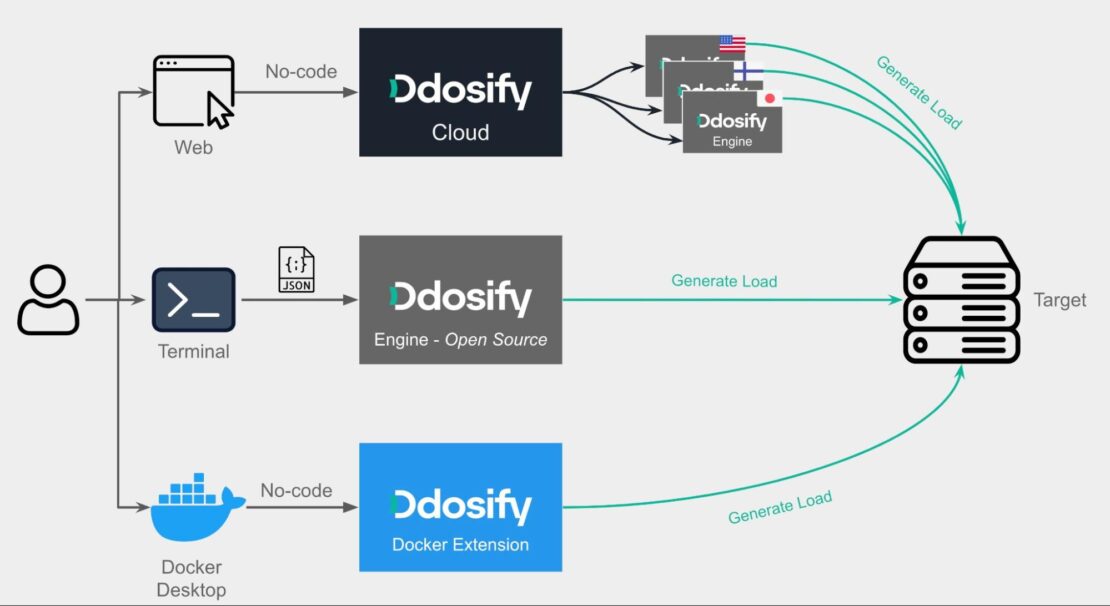
Why Ddosify?
Ddosify is easy to use and offers many features, including dynamic variables, CSV data import, various load types, correlation, and assertion. Ddosify also has different options for different use cases. If you are an individual developer, you can use the Ddosify Engine or Ddosify Docker Extension free of charge. If you need code-free load testing, advanced reporting, multi-geolocation, and more requests per second (RPS), you can use the Ddosify Cloud.
With Ddosify, you can:
- Identify performance issues of your application by simulating high user traffic.
- Optimize your infrastructure and ensure that you are only paying for the resources that you need.
- Identify bugs before your customers do. Some bugs are only triggered under high load.
- Measure your system capacity and identify its limitations.
Why run Ddosify as a Docker Extension?
Docker Extensions help you build and integrate software applications into your daily workflows. With Ddosify Docker Extension, you can easily perform load testing on your application from within Docker Desktop. You don’t need to install anything on your machine except Docker Desktop. Features of Ddosify Docker Extension include:
- Strong community with 6K+ GitHub stars and a total of 1M+ downloads on all platforms. Community members contribute by proposing/adding features and fixing bugs.
- Currently supports HTTP and HTTPS protocols. Other protocols are on the way.
- Supports various load types. Test your system’s limits across different load types, including:
- Dynamic variables (parameterization) support. Just like Postman, Ddosify supports dynamic variables.
- Save load testing results as PDF.
Getting started
As a prerequisite, you need Docker Desktop 4.10.0 or higher installed on your machine. You can download Docker Desktop from our website.
Step 1: Install Ddosify Docker Extension
Because Ddosify is an extension partner of Docker, you can easily install Ddosify Docker Extension from the Docker Extensions Marketplace (Figure 2). Start Docker Desktop and select Add Extensions. Next, filter by Testing Tools and select Ddosify. Click on the Install button to install the Ddosify Docker Extension. After a few seconds, Ddosify Docker Extension will be installed on your machine.
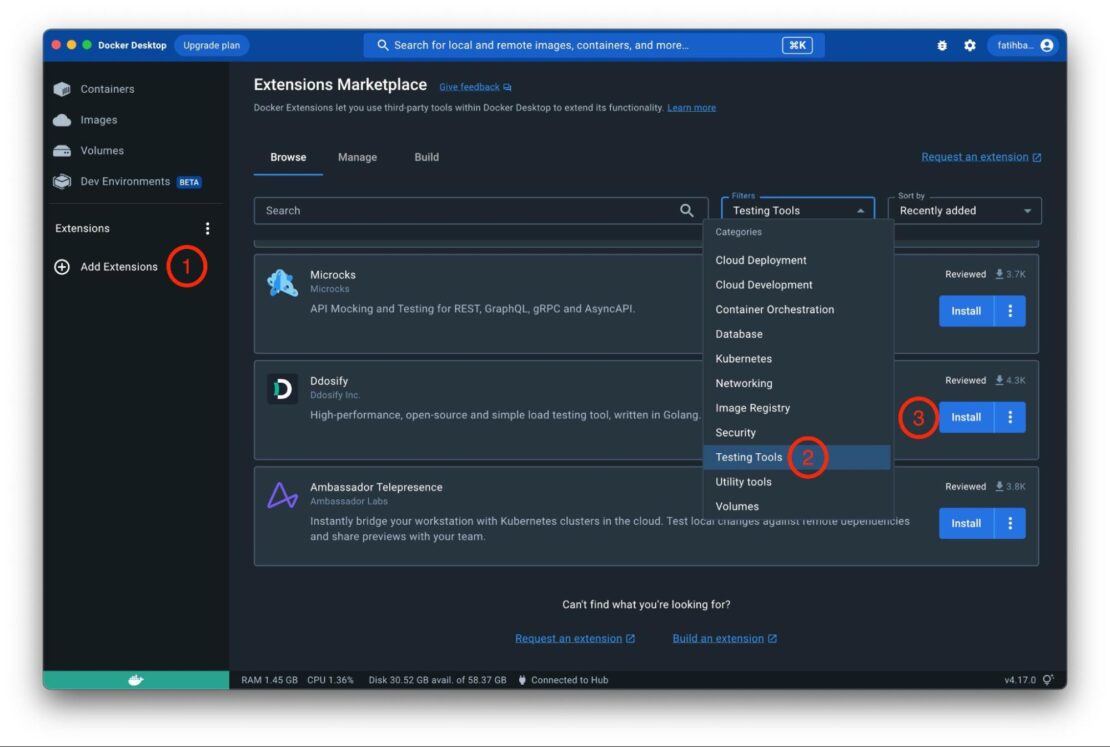
Step 2: Start load testing
You can start load testing your application from the Docker Desktop (Figure 3). Start Docker Desktop and click on the Ddosify icon in the Extensions section. The UI of the Ddosify Docker Extension will be opened.
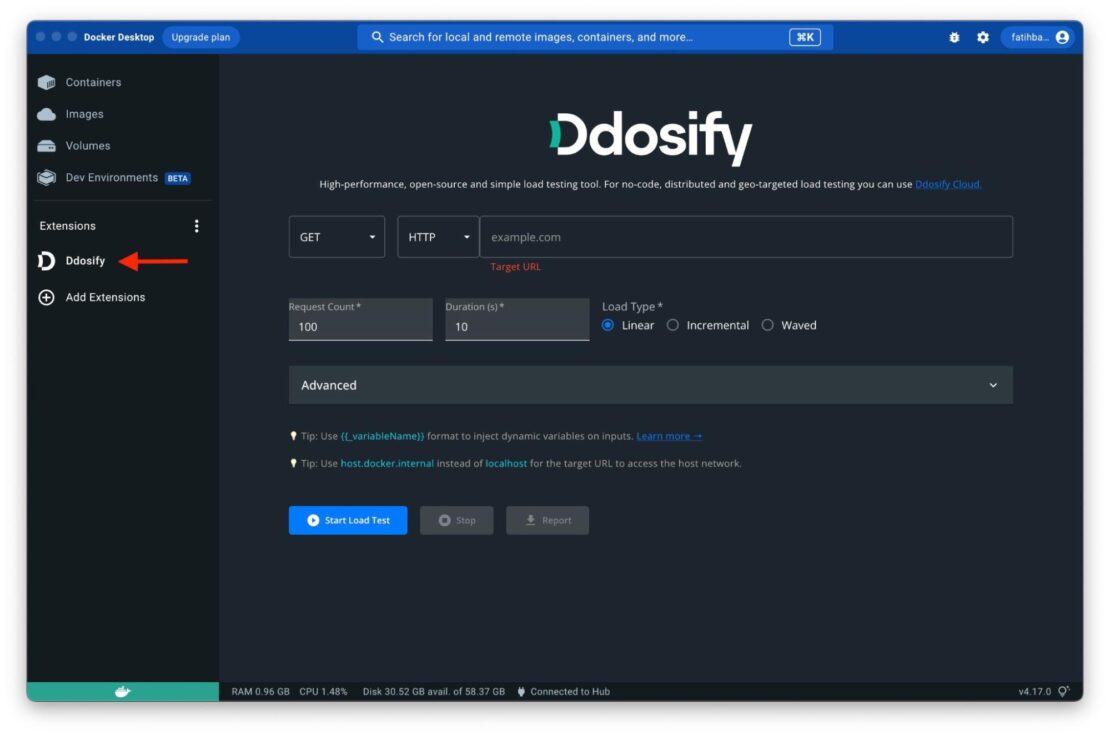
You can start load testing by entering the target URL of your application. You can choose HTTP Methods (GET, POST, PUT, DELETE, etc.), protocol (HTTP, HTTPS), request count, duration, load type (linear, incremental, waved), timeout, body, headers, basic auth, and proxy settings. We chose the following values:
| URL: | https://testserver.ddosify.com/account/register/ |
| Method: | POST |
| Protocol: | HTTPS |
| Request Count: | 100 |
| Duration: | 5 |
| Load Type: | Linear |
| Timeout: | 10 |
| Body: | {“username”: “{{_randomUserName}}”, “email”: “{{_randomEmail}}”, “password”: “{{_randomPassword}}”} |
| Headers: | User-Agent: DdosifyDockerExtension/0.1.2Content-Type: application/json |
In this configuration, we are sending 100 requests to the target URL for 5 seconds (Figure 4). The RPS is 20. The target URL is a test server that is used to register new users with body parameters. We are using dynamic variables (random) for username, email, and password in the body. You can learn more about dynamic variables from the Ddosify documentation.
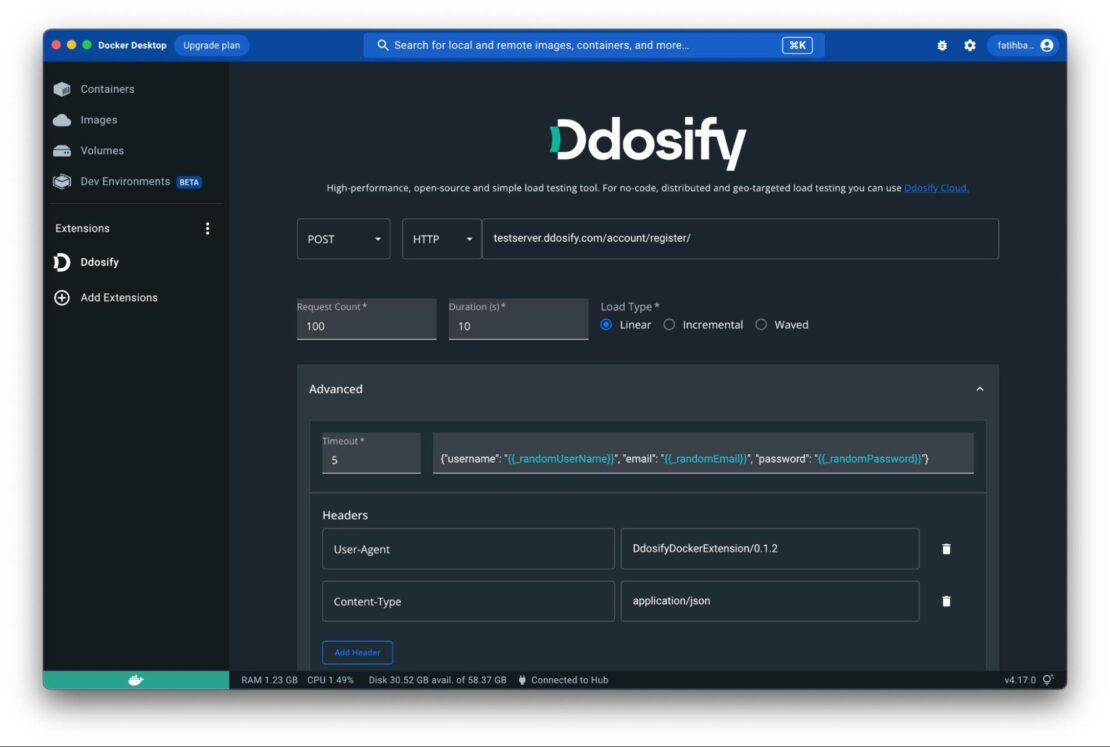
Then click on the Start Load Test button to begin load testing. The results will be displayed in the UI (Figure 5).

The test results include the following information:
- 48 requests successfully created users. Response Code: 201
- 20 requests failed to create users because of the duplicate username and emails with the server. Response Code: 400
- 32 requests failed to create users because of the timeout. The server could not respond within 10 seconds, so we should increase the timeout value or optimize the server
You can also save the load test results. Click on the Report button to save the results as a PDF file (Figure 6).
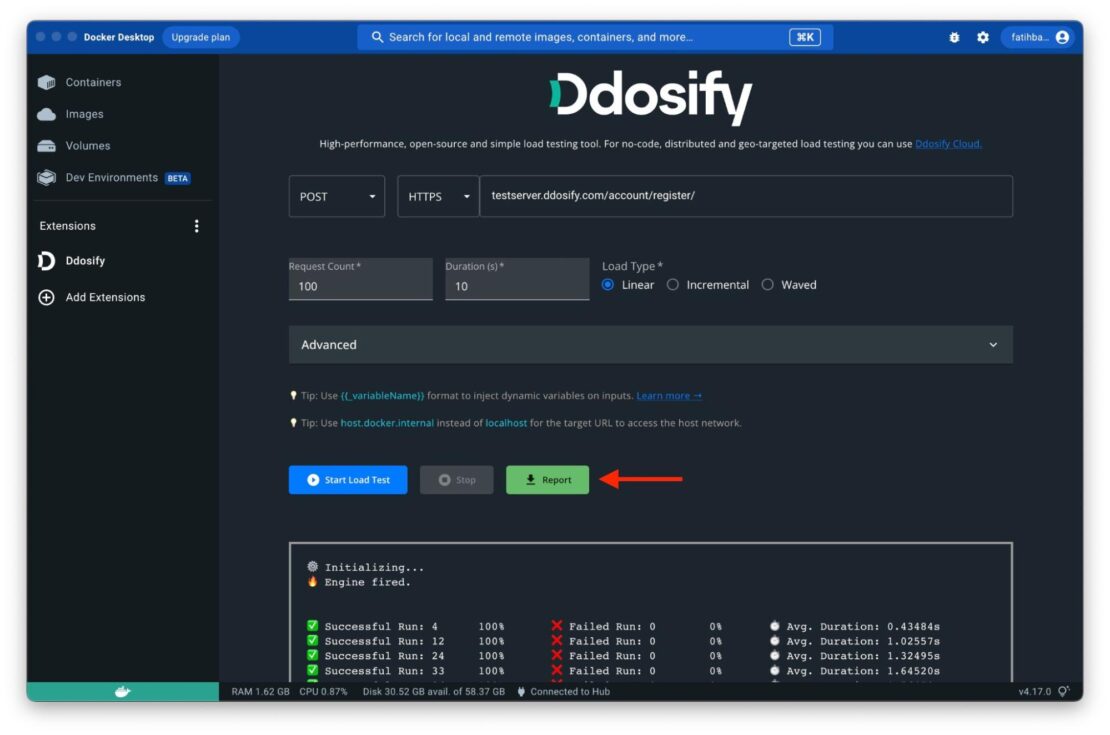
Conclusion
In this article, we showed how to install Ddosify Docker Extension and quickly start load testing your application from Docker Desktop. We created random users on a test server with 100 requests for 5 seconds, and we saw that the server could not handle all the requests because of the timeout.
If you need help with Ddosify, you can create an issue on our GitHub repository or join our Discord server.

